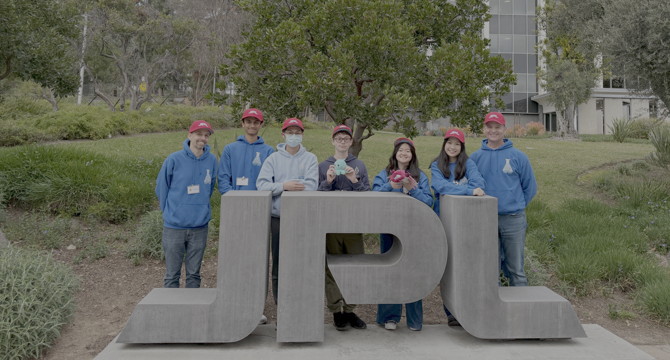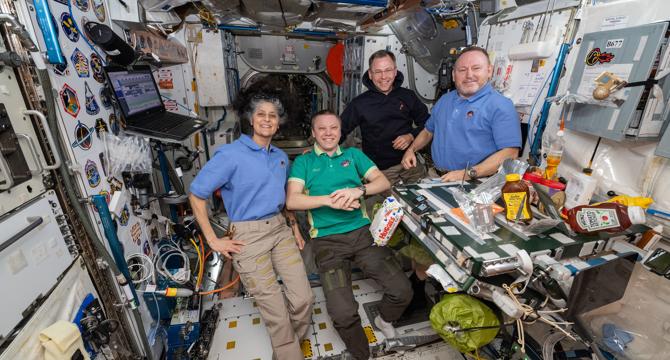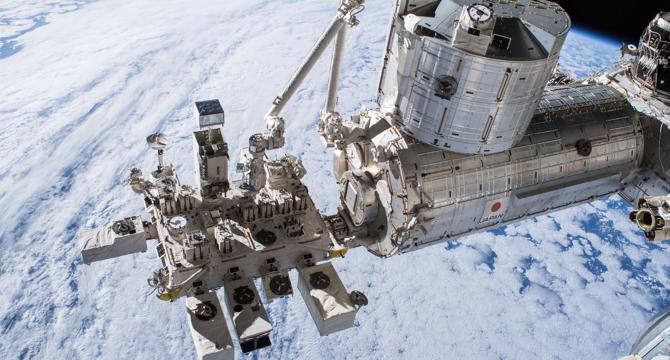Space News
Nasa
136

Image Credit: Nasa
Orion Deputy Program Manager Debbie Korth Receives 2025 Engineer of the Year Award
- Debbie Korth, Orion deputy program manager at Johnson Space Center, has been named NASA’s 2025 Engineer of the Year by the National Society of Professional Engineers.
- Korth has dedicated over 30 years of her career to NASA, supporting various space programs such as the Space Shuttle, International Space Station, and Orion Programs.
- She has played crucial roles in integrating equipment and managing spaceflight hardware for missions, including collaborations with Russian counterparts.
- Currently, Korth is working on the design, development, and certification of Orion spacecraft for Artemis missions, with major milestones planned for 2025.
Read Full Article
8 Likes
Guardian
90
Image Credit: Guardian
Chile’s perfect skies for stargazing under threat from giant chemical plant
- Chile's Atacama desert offers the darkest, clearest skies for stargazing, attracting astronomers from around the world.
- The proposed Inna project, a 3,000-hectare industrial-scale green hydrogen and ammonia plant, threatens Chile's observatories.
- Located just 11.6km from a crucial observatory, the project's size and illumination pose a significant threat to astronomical readings.
- The environmental regulator expressed concerns about the project's impact on the observatories but did not halt its progress.
- Scientists fear that light pollution from the plant, construction dust, and atmospheric turbulence could hinder astronomical research.
- The Paranal observatory, home to the VLT and winner of three Nobel prizes, requires dark skies for optimal data collection.
- ESO's director in Chile emphasizes the need for pristine skies to advance our understanding of the universe.
- Astronomers argue that the economic benefits of the Inna project do not justify the potential loss of astronomical research opportunities.
- Chile's regulations on light pollution aim to protect dark skies as a fundamental right, highlighting the conflict with industrial developments.
- Calls for stricter controls on light pollution to preserve the night sky's integrity and ensure future discoveries in astronomy.
- The battle between economic interests and scientific advancement intensifies as Chile wrestles with the balance between development and environmental conservation.
Read Full Article
5 Likes
Nasa
13

Image Credit: Nasa
Sols 4468-4470: A Wintry Mix of Mars Science
- Curiosity continues to climb roughly southward through the layered sulfate strata toward the “boxwork” features.
- The team made the most of the imaging and LIBS observations available from the rover’s current location.
- The plan includes observing recurring atmospheric phenomena and monitoring the modern environment on Mars.
- APXS atmospheric observation and ChemCam passive-sky observation have been scheduled to measure specific components in the Martian atmosphere.
Read Full Article
Like
Medium
208

Image Credit: Medium
Forget Mars — The Real Money in Space is Being Made in Low Earth Orbit
- The future of manufacturing is shifting to Low Earth Orbit as space provides a unique environment for creating materials purer, stronger, and more efficient than those made on Earth.
- Blue Origin's long-term vision includes moving polluting industries off Earth, and new commercial space companies see the potential for quality advantages in space manufacturing.
- The microgravity environment in space eliminates limitations caused by gravity, enabling the production of superior materials like crystals and semiconductors with fewer errors.
- Accessible LEO has expanded opportunities for both large corporations and small startups, with reusable rockets lowering the cost barrier for launching into space.
- Certain industries like semiconductors are poised to benefit significantly from manufacturing in space due to the unique advantages offered by microgravity.
- NASA's programs like InSPA allow companies to use the ISS as a research lab to advance manufacturing processes in space, attracting investors with proof-of-concept experiments.
- The space economy is valued at $500 billion in 2025, projected to reach $1 trillion in the near future with a shift towards commercial space stations and private-sector innovation.
- Benefiting from advancements in space manufacturing, future generations may see products like pharmaceuticals and electronic components crafted in space, transforming industries on Earth.
- Companies like SpaceX, Rocket Lab, and Blue Origin have led the way in revolutionizing the launch market, making manufacturing in microgravity more accessible and feasible for various enterprises.
- As space becomes the new frontier for industrial development, the opportunities lie not in distant planets like Mars, but in Low Earth Orbit, paving the way for a trillion-dollar future.
- The potential for space manufacturing to revolutionize industries on Earth is comparable to the emergence of industries like the internet, AI, or renewable energy, marking a significant shift in our economic landscape.
Read Full Article
12 Likes
Discover more
Nasa
331

Image Credit: Nasa
Interview with Sean Colgan
- Sean Colgan, an astronomer, shares details of his life and career in an interview conducted by Fred Van Wert and Mark Vorobets.
- Colgan was born in Oakland and spent his formative years split between Oakland and North Lake Tahoe, where his father was a masonry contractor.
- From a young age, Colgan was fascinated by astronomy and eventually pursued it as a career, specializing in radio astronomy.
- He attended UC Riverside and transferred to Caltech to focus on astronomy, facing intense competition and workload at Caltech.
- Colgan later worked on the Kuiper Airborne Observatory (KAO) and transitioned to the Stratospheric Observatory for Infrared Astronomy (SOFIA) project.
- His most memorable work involved observing Supernova 1987A, where his team made significant findings in radio astronomy.
- Colgan's current focus involves data processing and archiving for SOFIA, showcasing his dedication to NASA missions throughout his career.
- Outside of work, Colgan enjoys gardening, music events, and travel with his wife, who is a skilled lacemaker.
- Despite his successful career in astronomy, Colgan emphasizes the role of luck and timing in one's professional journey.
- The interview delves into personal details, such as Colgan's 40-year marriage, travel experiences, and his wife's passion for lacemaking.
- Colgan's favorite quote, 'The reward for good work is more work,' reflects his work ethic and commitment to continuous improvement.
Read Full Article
19 Likes
Knowridge
363

Image Credit: Knowridge
James Webb Telescope finds planet-forming disks last longer than expected
- Astronomers using the James Webb Space Telescope have found a 30-million-year-old protoplanetary disk, three times older than expected.
- Most planet-forming disks around young stars disappear after about 10 million years, but this discovery suggests certain disks can survive much longer.
- The longevity of these disks is more common in small stars, allowing planets more time to form.
- This finding has implications for understanding planetary formation and the conditions for life in the universe.
Read Full Article
21 Likes
TechnologyReview
222

Image Credit: TechnologyReview
Should we be moving data centers to space?
- Company Lonestar Data Holdings launched a device carrying data to the moon to test the idea of moving data centers off Earth.
- Moving data centers to space could address issues like energy consumption, land use, and security concerns.
- Lonestar aims to offer commercial data storage service with satellites at Earth-moon Lagrange point L1 by 2027.
- Other companies like Axiom and Starcloud also have plans for data processing in space.
- In-space data centers could expedite processes, save costs, and provide a more secure data storage option.
- Challenges for space data centers include harsh conditions, power supply, launch costs, and environmental impact.
- Orbiting data centers are considered more environmentally friendly due to solar power availability and heat dispersal in space.
- Security benefits of space-based data centers include protection from sabotage and natural disasters.
- However, challenges like equipment damage from energetic particles and rocket launch costs need to be addressed for the feasibility of space data centers.
- Moving data centers to space could support lunar economy growth and future space exploration needs.
Read Full Article
13 Likes
Brighter Side of News
99

Image Credit: Brighter Side of News
NASA’s Hubble telescope captures vivid new images of Andromeda’s satellite galaxies
- NASA's Hubble telescope has captured new images of Andromeda's satellite galaxies, revealing differences in their evolutionary paths compared to Milky Way satellites.
- Observations of Andromeda's satellites challenge previous assumptions about galaxy evolution, highlighting variations in properties and histories.
- Andromeda's satellites provide insights into dark matter, galaxy formation, and cosmic reionization, indicating potential differences in evolutionary paths based on environment.
- The Pan-Andromeda Archaeological Survey identified new satellites and remnants of galactic collisions, shedding light on the complex interactions shaping Andromeda's system.
- Hubble's extensive research on Andromeda's satellites has revealed surprising findings, including an unexpected alignment of half of the satellites moving in a coordinated manner.
- Differences in star formation histories between Andromeda's satellites and Milky Way's suggest Andromeda's turbulent past and unique evolutionary paths.
- Future studies using Hubble and JWST will focus on tracking the motion of Andromeda's satellites to reconstruct their past interactions and study compositions in greater detail.
- The study of Andromeda's satellite galaxies aims to answer fundamental questions about galaxy evolution and the universe, offering insights into star formation processes and galaxy mergers.
- Understanding Andromeda's satellite system is essential for unraveling mysteries in cosmology and may provide key insights into the evolution of galaxies in different environments.
- Future telescopes like JWST and Habitable Worlds Observatory will further enhance research on Andromeda's satellites, potentially comparing them to those in more distant galaxies.
Read Full Article
6 Likes
Nasa
154

Image Credit: Nasa
University High Knows the Answers at NASA JPL Regional Science Bowl
- A team from University High School of Irvine, California, won the 2025 regional Science Bowl at NASA’s Jet Propulsion Laboratory.
- The competition involved students answering challenging questions across various science and math topics.
- The event drew schools from across Los Angeles, Orange, and San Bernardino counties, with University High School emerging as the winner.
- The victory enables the University High School team to compete in the national finals in Washington in late April.
Read Full Article
9 Likes
Popsci
13

Image Credit: Popsci
Candy-colored atoms shine in new image of the Veil Nebula
- The NASA/ESA Hubble Space Telescope has captured a new image of the Veil Nebula, a famous supernova remnant.
- The image shows colorful atoms emitted by different types of atoms in the hot gas of the nebula.
- The Veil Nebula is located approximately 2,400 light-years away in the constellation Cygnus.
- The Hubble Space Telescope has previously photographed the Veil Nebula in 1994, 1997, and 2015, providing insights into its evolution over time.
Read Full Article
Like
Nasa
108

Image Credit: Nasa
NASA Astronauts to Answer Questions from Students in Ohio, Texas
- NASA astronauts aboard the International Space Station will answer prerecorded questions from students in Ohio and Texas.
- On March 5, astronauts Suni Williams, Nick Hague, Butch Wilmore, and Don Pettit will respond to questions from Puede Network in Dallas.
- On March 6, astronauts Williams, Hague, and Wilmore will answer questions from students at Saint Ambrose Catholic School in Brunswick, Ohio.
- These 20-minute space-to-Earth calls can be watched on NASA+.
Read Full Article
6 Likes
Nasa
31

Image Credit: Nasa
Station Science Top News: Feb. 27, 2025
- Two anti-microbial coatings show potential in reducing biofilm formation in microgravity and could be used in space to protect human health and prevent equipment degradation.
- Researchers found different gene expression and other responses to simulated lunar gravity levels in specific organs, which could help determine safe gravity thresholds for future space journeys.
- The on-orbit performance of the International Space Station's cosmic ray observatory, CALET, has been successful in providing valuable data on various aspects of cosmic rays, including gamma-ray detection and searching for gravitational wave counterparts.
- The JAXA CALorimetric Electron Telescope (CALET) is instrumental in studying the origin and acceleration of cosmic rays, as well as assessing the risks from the radiation environment in space.
Read Full Article
1 Like
Brighter Side of News
426

Image Credit: Brighter Side of News
Scientists may have finally found the way to directly detect dark matter
- Scientists have long sought to detect dark matter, an invisible substance that influences the universe, with its properties still unknown.
- Recent research explores the detection of axion-like particles (ALPs), theorized particles that could explain dark matter mysteries.
- A team from Tokyo Metropolitan University used advanced infrared spectrographs to search for dark matter decay signals.
- Utilizing the WINERED instrument in Chile, the researchers observed galaxies for signs of ALP decay emissions.
- While no direct detection was made, the study provided constraints on dark matter decay rates within specific mass ranges.
- The findings highlight the importance of advanced technology in advancing dark matter research.
- Their work complements other dark matter detection methods, offering a new perspective in the search for cosmic mysteries.
- The results indicate a significant step forward in understanding dark matter, setting the stage for further investigations and discoveries.
- Despite challenges, scientists remain dedicated to unraveling the enigma of dark matter, aiming to uncover its true nature with continued research.
- Through ongoing observations and method refinements, researchers strive to piece together the puzzle of dark matter.
Read Full Article
25 Likes
For uninterrupted reading, download the app